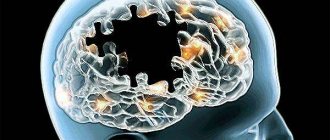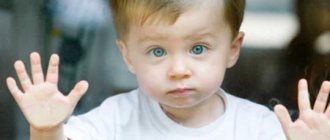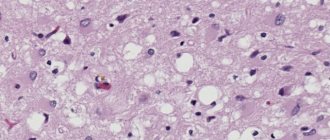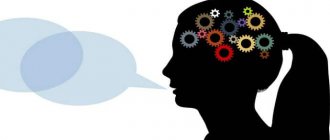Visual-figurative thinking
- a set of methods and processes for imaginative problem solving, involving a visual representation of a situation and operating with images of its constituent objects, without performing real practical actions with them. Allows you to most fully recreate the variety of various factual characteristics of an object, for example, to recognize a school friend in an aged face. An important feature of this type of thinking is the establishment of unusual combinations of objects and their properties. The functions of imaginative thinking are associated with imagining situations and changes in them that a person wants to obtain as a result of his activities that transform the situation, with the specification of general provisions. [1].
The right hemisphere is responsible for visual and figurative thinking
brain
Visual-figurative thinking leads to instant
results.
A type of thinking that develops in a child at the age of 2-3 years and forms the dominant part of his behavior until the age of 6-7 years, where the main unit is the image. Like action, a child’s image is characterized by syncretism, an abundance of private connections, randomness in the choice of features, and a large amount of subjectivity with a predominance of emotional components. In the Vygotsky-Sakharov test, when a child is offered a collection of figurines of various colors, sizes and shapes and is asked to divide it into several more homogeneous groups, the child is led by the most striking superficial signs, for example, collecting figurines of the same color or the same shape, which is a mistake classifications. Jean Piaget, who studied children's thinking for many years, discovered one specific feature in children, which was even later called the Piaget effect. If you show a child a ball made of plasticine, then in front of his eyes turn this ball into a cake and ask where there is more plasticine, the child will point to the cake, since it takes up more space. This is precisely a demonstration that the child still lacks the ability to abstract from primary signs and transition to a higher generalization. Visual-effective and visual-figurative types of thinking are combined into the group of pre-conceptual thinking, since the operation of concepts here is of a random, unconscious nature, and the basis is a direct and concrete reflection of reality. This is a kind of connecting link between perceptual processes and abstract mental, mediated signs and symbols. Visual-figurative thinking is available for psychological research using various methods, where the leading role is played by perceptual elements: color, shape, adequacy of the image of any object or phenomenon. The most common methods: using Koss cubes, Raven's progressive matrices, eliminating unnecessary things in pictures, classifying pictures, pictograms. The criteria for the development of visual-figurative thinking can be different - from the correctness of the task and speed to the degree of originality and abstractness. Visual-effective, visual-figurative, verbal-logical thinking form the stages of development of thinking in ontogenesis, in phylogenesis. Currently, psychology has convincingly shown that these three types of thinking coexist in adults and function when solving various problems. [2]. It depends on the type of professional activity, personal and individual psychological characteristics. [3].
About 30% of students from 4th to 6th grade use predominantly imaginative thinking to remember rules and solve problems, about 25% use predominantly sequential-logical thinking, and 45% use both hemispheres[4].
Features in children
- Reflection through generalization. Participants in the thought process are always a person’s general ideas about phenomena, objects and events. People build a cause-and-effect relationship by generalizing from a huge number of facts that they have encountered in the past.
- Mediation of cognition. In their thoughts, each individual relies on his own feelings, emotions and experiences.
- Solving various situations. Finding a way to resolve a particular problem always has approximately one scenario: first, an analysis of what is happening, then a selection of the most suitable options for action. The quest may proceed through trial and error, in a rational or irrational manner.
- Direct connection with speech. Thinking is directly related to the speech functions of the individual. Any idea, plan, idea is formulated verbally and expressed verbally.
The main characteristics of objects and phenomena, as well as their interconnections and relationships, define concepts. They are applicable and the more important features served as the foundation for them, the more effective human activity will be.
A judgment is a reflection of the connection between objects in the form of affirmative or negative statements. It is based not only on knowledge about something, but also on subjective assessments based on the attitude towards its truth.
An inference is a combination of several considerations that can ultimately be transformed into a logical conclusion. Mental activity is based on deduction, induction and the use of analogies.
Certain personality characteristics can also influence the way you think.
Male
As a rule, it is based on logical analysis and is aimed at creating a plan of specific actions. It is characterized by purposefulness, rationality and alienation of the mind from sensations. Men strive to move from thinking to action and achieving a certain result, and emotions only interfere with the process of comprehension.
Women's
Most often it has an intuitive basis, which is almost always accompanied by sensory experience. Specification and detail of information play an important role. A woman’s way of thinking can change under the influence of her mood, although many girls have logic, rationalism, and the ability to plan and analyze.
It can be difficult for girls to understand themselves and understand the intricacies of reality. In such situations, I will be happy to help. Sign up for my consultation, and I will tell you how to effectively and efficiently use internal resources and turn femininity into a powerful source of energy.
Positive
People with this type of thinking are more likely to see opportunities around them rather than obstacles. No matter what happens, they strive to maintain an optimistic attitude, while being realistic and constructive in assessing the situation and finding in it what contributes to success.
Negative
Accompanied by emotions associated with dissatisfaction with life and pessimism. People of this mindset tend to passively criticize what is happening, express their unpleasant feelings and thoughts, but do not always take responsibility for solving the problem that has arisen.
Strategic
It is possessed by individuals who prefer to plan their activities far ahead and know how to set long-term goals. They stick to their plan and see the most effective ways to achieve their plans. As a rule, these are good managers and businessmen.
Idealistic
Instead of understanding the world, idealists create a model of it in their heads, which they try to impose on reality. Most often, these pictures do not match, which causes negative emotions and experiences in a person. An individual with such a mentality may not notice the obvious due to this desire for illusions.
Irrational
An irrational person does not always manage to see and understand the reasons for his actions. He does not analyze, does not criticize, but simply believes in what he does. For him, the most important thing is the effectiveness of actions, and not the logic or objectivity of the assessment.
Rational
Unlike the previous one, the rational refers only to facts, knowledge and skills. He pushes sensations and emotions into the background, preferring to think soberly, constructively, quickly and logically solving assigned tasks.
Analytical
A person with this way of thinking relies solely on logic. He is sure that everything has a cause-and-effect relationship, so to solve a problem you need to analyze for a long time, study the situation and get to the bottom of the root cause.
Synthesizing
Well developed among those who are able to recreate a complete and understandable picture of reality from individual pieces of information. Such people are not afraid of routine work and prefer stability rather than change. They perceive the world around them with caution. Personalities of this type often make outstanding scientists.
Imaginative thinking is the main type in children.
Preschool age
The development of the ability to think in images occurs in children aged 4-5 years.
They draw schematic images, fantasize and compose.
Imaginative thinking develops a response to works of art and helps to identify intangible values. During this period, the emotional component predominates.
At 5-6 years old, the ability to transform an object and space in the mind appears. A preschooler can imagine the world in three dimensions.
In preschool age, the first ideas about life experience and attempts to use it develop.
In elementary school, developed imaginative thinking helps the child solve problems based on diagrams and drawings. A characteristic feature of younger schoolchildren is the ability to control thinking. Schoolchildren begin to become interested in phenomena and objects, highlighting the most striking features and assigning them to imaginary objects.
Middle classes
During this school period, the development of figurative-sensual thinking continues and curiosity increases.
Teenagers
Feelings come to the forefront, embodied in images, and teenagers begin to draw and write poetry. For them, the conceptual figurative sphere becomes important, he is immersed in the figurative-symbolic world, and reality fades into the background. Thought processes are closely related to perception. The lack of life experience makes it difficult to compare the imaginary system of images with reality.
We invite you to familiarize yourself with Salicylic-zinc paste. Instructions for use for eczema, inflammation of moles, acne, age spots, blackheads, armpit sweating
Abstract boolean type
Abstract thinking operates not only with images, but also with abstract concepts. A person who has developed this type of mental activity is able to systematize information and purposefully search for it, and plan his activities. It is considered the highest degree of development of brain activity, characteristic only of humans.
The formation of abstract thinking begins at 5-7 years of age. Late preschool and early school period. The full ability to operate with abstract concepts is formed in adolescents and remains throughout life.
Signs that a preschooler has begun to develop logical thinking:
- meaningful use of abstract concepts in speech,
- the emergence of the skill of detailed planning of one’s activities,
- understanding cause-and-effect relationships in the actions of others.
All these operations occur without direct contact with objects.
Impaired brain activity manifests itself in the inability to generalize, highlight the main thing, and understand the figurative meaning of words and expressions. To identify such disorders, tests are used in which you need to interpret a proverb or saying and identify fundamental similarities between different objects.
Peculiarities
This type of thinking uses complex logical operations. In adolescents and adults it is the main one. Thanks to it, a person is able to plan, set goals and evaluate their feasibility, evaluate his own actions and the actions of others, draw conclusions and learn from his own and others’ experiences. Characterized by deep attention to detail, understanding of context, low emotional involvement.
Operations of thinking
- Comparison is a comparison of objects or phenomena, searching for their similarities and differences.
- Analysis is the identification of specific characteristics and properties in an object.
- Synthesis is the combination of a number of elements into a whole.
- Abstraction is a distraction from the general and highlighting one side.
- Generalization is the ability to group similar features.
- Operations are unique units of measurement for thinking. At their expense, mental activity is carried out. They are present at any stage of development of intellectual abilities, but manifest themselves in different forms.
- Comparison is the search for differences and similarities between objects. Based on comparison, objects can be grouped based on similarity.
- Analysis is the division of an object into its components. At the simplest stage, it is accompanied by physical separation of the object (the child breaks toys).
- Synthesis is an operation opposite to analysis - recreating the appearance of a whole object from its parts.
- Abstraction is the selection of essential features of an object, ignoring non-essential ones.
- Concretization is an operation opposite to abstraction - identifying the specific characteristics of an object, perceiving its diversity.
- Induction is the derivation of conclusions from the particular to the general, the distribution of knowledge about a specific object to the entire group of similar objects.
- Deduction is an operation opposite to induction - drawing conclusions from the general to the particular, distributing knowledge about a group of objects to each object of this group.
- Classification is the division of objects according to their differences. Performed on a comparison basis.
- Generalization - identifying common features for different objects. This operation is performed on a comparison basis.
Visual-effective thinking
Visual-effective thinking is, as the name suggests, practical actions with real objects, as a result of which a person develops, learns, solves problems, understands the world around him, its phenomena, and establishes relationships between objects.
Visual and effective thinking is the most primary link in the formation of human thinking, it triggers the work of the brain. It actively develops in the first stage of its life from 0 to 3 years. All the child’s senses are involved in this process: smell, touch, vision, hearing and taste. That’s why it’s so important for the child to crumple and tear the paper; got acquainted with objects of different shapes, structures, tastes and smells; threw it, broke it, tried it out, built it, etc. This is not self-indulgence, but necessary work for human development. There must be adults nearby to show, surprise or stop at the slightest danger.
But even after three years, the development of visual and effective thinking does not stop, but only strengthens the strengths of the individual:
- ability to observe;
- carry out experiments;
- analyze the results.
In adults, this form of thinking has acquired a new meaning - manual thinking. Skillful hands can create a masterpiece, recreate an item from trash, give a person a second life, or simply make high-quality repairs. Surgeons, inventors, scientists, mechanics, builders and people of many other professions cannot do without such “simple” thinking in their activities.









